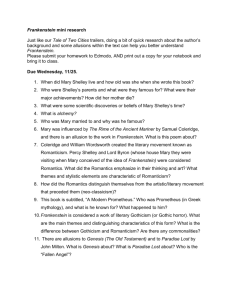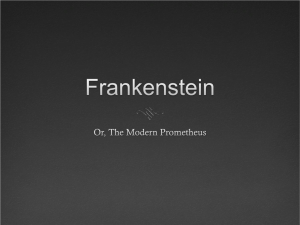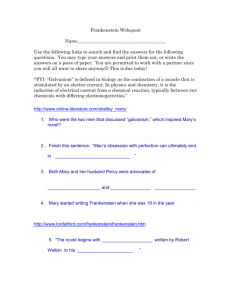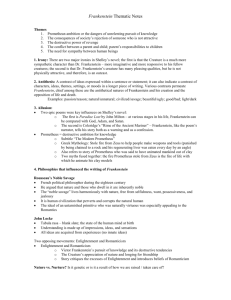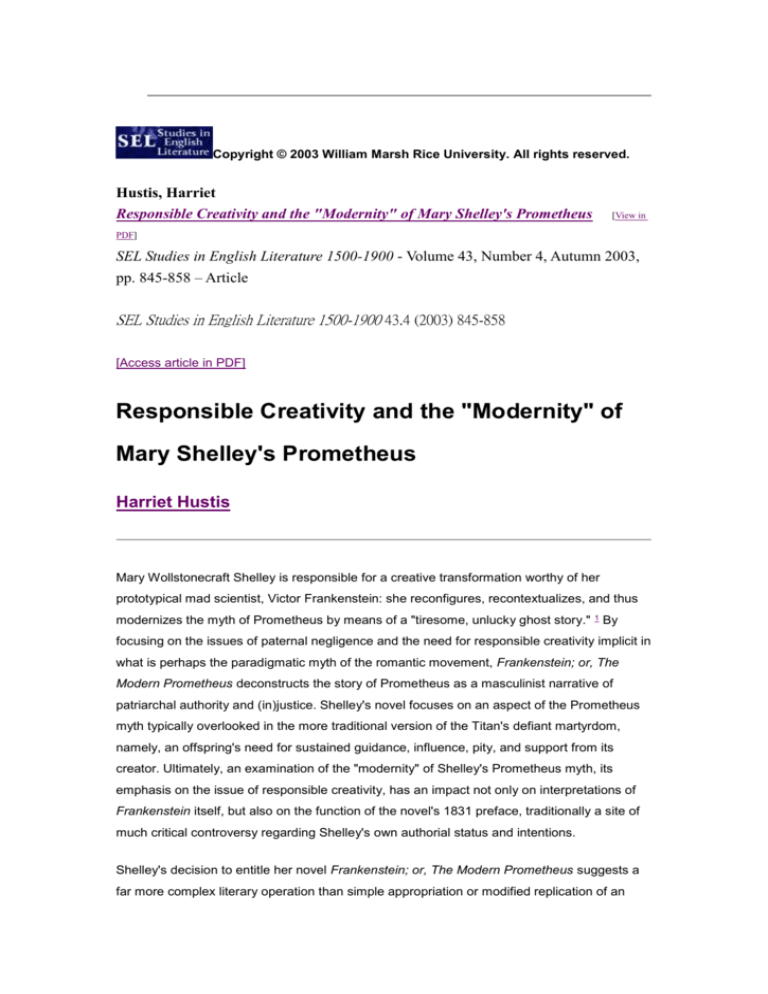
Copyright © 2003 William Marsh Rice University. All rights reserved.
Hustis, Harriet
Responsible Creativity and the "Modernity" of Mary Shelley's Prometheus
[View in
PDF]
SEL Studies in English Literature 1500-1900 - Volume 43, Number 4, Autumn 2003,
pp. 845-858 – Article
SEL Studies in English Literature 1500-1900 43.4 (2003) 845-858
[Access article in PDF]
Responsible Creativity and the "Modernity" of
Mary Shelley's Prometheus
Harriet Hustis
Mary Wollstonecraft Shelley is responsible for a creative transformation worthy of her
prototypical mad scientist, Victor Frankenstein: she reconfigures, recontextualizes, and thus
modernizes the myth of Prometheus by means of a "tiresome, unlucky ghost story." 1 By
focusing on the issues of paternal negligence and the need for responsible creativity implicit in
what is perhaps the paradigmatic myth of the romantic movement, Frankenstein; or, The
Modern Prometheus deconstructs the story of Prometheus as a masculinist narrative of
patriarchal authority and (in)justice. Shelley's novel focuses on an aspect of the Prometheus
myth typically overlooked in the more traditional version of the Titan's defiant martyrdom,
namely, an offspring's need for sustained guidance, influence, pity, and support from its
creator. Ultimately, an examination of the "modernity" of Shelley's Prometheus myth, its
emphasis on the issue of responsible creativity, has an impact not only on interpretations of
Frankenstein itself, but also on the function of the novel's 1831 preface, traditionally a site of
much critical controversy regarding Shelley's own authorial status and intentions.
Shelley's decision to entitle her novel Frankenstein; or, The Modern Prometheus suggests a
far more complex literary operation than simple appropriation or modified replication of an
ancient Greek myth; it simultaneously invokes a literary paradigm and establishes a point of
comparison or, more accurately, a point of departure, for her own creative endeavor. As
Christopher Small has observed, Mary Shelley's Prometheus figure is strikingly different from
the creations of her romantic contemporaries: "Frankenstein, her Prometheus, while sharing
the impious and agonised [End Page 845] qualities that exerted such fascination on the
Romantics, is Promethean first and foremost as a maker of man, an aspect of the legend that
has tended to be obscured in emphasis on the primary Promethean act of stealing fire from
heaven." 2 In his introduction to Mary Shelley's "Frankenstein," Harold Bloom suggests that
this difference is indicative of the inferiority of Mary Shelley's creative conception; he thus
regards Frankenstein as a kind of primer to the more sophisticated and imaginatively complex
texts of Lord Byron, William Blake, and Percy Shelley. 3 In Revision and Romantic Authorship,
however, Zachary Leader argues that "Frankenstein is anti-Romantic in its rejection of what
might be called the 'Promethean' vision of the artist (as God-like, autonomous, transgressive),
and of the goal of perfection." 4 Thus, Leader claims that Shelley advances a "critique of
'Promethean' Romanticism" by means of her "modern Prometheus," Victor Frankenstein.
5
And yet, in assessing the purpose and evaluating the success of Mary Shelley's divergence
from the original Prometheus legend, neither Leader nor Bloom looks closely enough at
precisely what her "modernization" does with (and to) this myth. A juxtaposition of the Greek
variants that appear in Hesiod's The Works and Days and Aeschylus's Prometheus Bound
with the text of Frankenstein itself suggests that Shelley reconfigures the significance of the
Prometheus myth in order to foreground the issue of responsible creativity. Thus, her novel
explores the ethics of a male creator's relationship to his progeny by questioning the extent to
which he incurs an obligation for the well-being and happiness of that creation by virtue of the
creative act itself.
Shelley's configuration of the Prometheus legend appears particularly "modern" when its
concern with the issue of responsible creativity is read in the context of Carol Gilligan's
analysis of the moral and psychological development of women. The insights of Gilligan's In A
Different Voice: Psychological Theory and Women's Development are strikingly applicable to
Frankenstein: like the subjects of Gilligan's abortion study, Victor Frankenstein also struggles
with the ethical consequences of an "unwanted pregnancy" of sorts, particularly when he
undertakes and then abandons the creation of a female mate for his monster. 6 In the figure of
Victor Frankenstein, Shelley innovatively problematizes the moral conflict between Zeus and
Prometheus established in the ancient Greek texts; by focusing on the way in which their
power struggle involves the issue of paternal negligence and the abuse of creative power, she
effectively reconfigures the significance of an ancient myth in decidedly feminist terms. As
Ellen [End Page 846] Moers persuasively argues in her landmark essay, "Female Gothic,"
Shelley "brought birth to fiction not as realism but as gothic fantasy, and thus contributed to
Romanticism a myth of genuine originality." 7 The result, Moers argues, is "a phantasmagoria
of the nursery." 8 Thus, it is not the case that Mary Shelley failed to comprehend the
complexities of the Prometheus myth and miraculously created a fictional masterpiece that is
simultaneously a naive reading of it. Rather, Shelley's rewriting of the Prometheus legend
reconceives its social and cultural significance in terms no less revolutionary than those of her
romantic contemporaries.
Significantly, although numerous studies of romantic literature have discussed the hubristic
defiance of the martyred Prometheus, it is only in Hesiod's account that Prometheus's actions
are motivated by self-interest; in The Works and Days, Prometheus steals fire, which Zeus has
hidden, gives it to mortals, and then hides it from Zeus himself. 9 His apparent motivation is an
innate mischievousness coupled with a desire to outwit Zeus; Hesiod's Prometheus is
essentially a trickster figure.
Aeschylus's Prometheus Bound, however, develops a more nuanced characterization of
Prometheus. Aeschylus's Prometheus defies Zeus; he does not simply trick him. Furthermore,
Prometheus's rebellion is overtly inspired by pity, an especially human emotion. Pity causes
Prometheus to undertake an act of daring responsibility: he steals fire for mortals in a gesture
of compassion for their neglected and benighted state:
As soon as [Zeus] ascended to the throne
that was his father's, straightway he assigned
to the several Gods their several privileges
and portioned out the power, but to the unhappy
breed of mankind he gave no heed, intending
to blot the race out and create a new.
Against these plans none stood save I: I dared.
I rescued men from shattering destruction
that would have carried them to Hades' house;
and therefore I am tortured on this rock,
a bitterness to suffer, and a pain
to pitiful eyes. I gave to mortal man
a precedence over myself in pity: I
can win no pity: pitiless is he
that thus chastises me, a spectacle
bringing dishonor on the name of Zeus. 10 [End Page 847]
Prometheus's audacity manifests itself not only in a solitary gesture of defiant compassion, but
also in the willing assumption of a creator's responsibility for his helpless progeny: he
subsequently nurtures human community by instructing Zeus's abandoned creatures in the
arts necessary for their survival, long-term happiness, and cultural evolution as a species.
11
Unlike Victor Frankenstein, who flees his creation in "breathless horror and disgust,"
apparently because it does not overtly embody the sublimity of his creative intentions,
Prometheus understands that revulsion in the face of hideousness can only be overcome by
an indulgence in benevolent pity, and he accepts the fact that such "daring" may come at a
considerable price (p. 318).
It is precisely such pity that Frankenstein's monster cannot obtain; Frankenstein openly
acknowledges that the most he can feel toward his creation is a fleeting sense of
"compassion" and a temporary urge to "console" him, impulses which are quickly
overwhelmed by disgust, "horror," and "hatred": "'I compassionated him and sometimes felt a
wish to console him, but when I looked upon him, when I saw the filthy mass that moved and
talked, my heart sickened and my feelings were altered to those of horror and hatred. I tried to
stifle these sensations; I thought that as I could not sympathize with him, I had no right to
withhold from him the small portion of happiness which was yet in my power to bestow'" (p.
414). As David Marshall persuasively argues in The Surprising Effects of Sympathy: Marivaux,
Diderot, Rousseau, and Mary Shelley, Frankenstein dramatizes the failure of the
eighteenth-century conception of "sympathy," which "suggests putting oneself in the place of
someone else, taking someone else's part—a general condition or act, related to the modern
word 'empathy,' of which pity, compassion, and commiseration are only specific examples."
12
Frankenstein's pity and compassion are purely intellectual responses to his creature's
helplessness and misery and thus cannot withstand the physical reality of the monster as a
"filthy mass that move[s] and talk[s]."
In effect, this failure of true sympathy mirrors the fundamental error of the monster's creation:
Frankenstein's decision to work on a large scale in order to avoid becoming bogged down by
(in his opinion) an unnecessary attention to detail. He thus acknowledges his unwillingness to
allow seemingly insignificant minutiae to impede the progress of his creative impulse; he is
interested in the principle of "life" only as an abstraction: "'Nor could I consider the magnitude
and complexity of my plan as any argument of its impracticability. It was with these feelings
that I began the [End Page 848] creation of a human being. As the minuteness of the parts
formed a great hindrance to my speed, I resolved . . . to make the being of a gigantic stature'"
(p. 314). Unwilling to acknowledge the "magnitude and complexity" of his task and thereby
practice responsible creativity, Frankenstein oversizes the "minuteness of the parts" in an
attempt to make the reality of his endeavor match the grandeur of his intentions. This
willingness to sacrifice creative precision for "speed" suggests that the creation of life is of
purely theoretical interest to Frankenstein: he thus conceives of life with blatant disregard for
its ("filthy," "hideous") specifics. Ultimately, this attitude will enable him to avoid grappling with
the moral complexities and physical impracticalities of life in its concrete manifestations.
13
Thus, for example, his narrative consistently extols the pleasures and sanctity of familial duty,
even as it narrates the systematic, if inadvertent, destruction of both his family and friends:
those who pay dearly for Frankenstein's actions are ironically those he claims to hold most
dear. Significantly, Frankenstein retrospectively transfers responsibility for the disasters he
helps to propagate onto poetic abstractions such as "Chance" or an "Angel of Destruction."
14
Interestingly, Carol Gilligan's In a Different Voice: Psychological Theory and Women's
Development addresses the consequences of this tendency to conceive of moral dilemmas in
purely hypothetical terms with respect to the crucial relationship explored in Frankenstein,
namely, the connection between responsibility and creativity. Such philosophical abstractions,
she argues, become "useful for the distillation and refinement of objective principles of justice
and for measuring the formal logic of equality and reciprocity." 15 However, not all moral
conflicts can be resolved by appeals to an ethics of justice: Gilligan thus observes how the
application of a "formal logic of equality and reciprocity" to a moral dilemma may ultimately
impede an "understanding of cause and consequence which engages . . . compassion and
tolerance" (p. 100).
It is precisely this kind of "understanding of cause and consequence" which eludes Victor
Frankenstein, as testified to by his insistent claims that an "Angel of Destruction" is responsible
for his misfortunes. Even more poignantly, however, Shelley's modernization of the
Prometheus legend suggests that what is lost when responsible creativity is conceived of
solely in terms of justice and a purportedly objective ethic of fairness is precisely what is the
most crucial element of this myth, namely, Promethean pity. Pity and the willingness to give
another precedence over oneself (regardless of whether s/he "deserves" it) are incompatible
with a [End Page 849] "formal logic of equality and reciprocity." And yet, the myth of
Prometheus suggests, the human race owes its survival and evolution as a species to such
seemingly illogical (unjust? unfair?) impulses.
The insufficiency of "objective principles of justice," no matter how "refined," is memorably
dramatized by the ongoing conflict between Frankenstein and his monster. Frankenstein's
response, when he cannot "sympathize" with his creature, is to seek to "measure the formal
logic of equality and reciprocity" by determining whether his own "rights" outweigh the "small
portion of happiness" he can offer him ("I had no right to withhold from him the small portion of
happiness which was yet in my power to bestow"). Although an ethic of justice ideally assumes
that all competing claims can be resolved objectively and perfect equity achieved, the inability
of Frankenstein and his monster to arrive at such moral reciprocity suggests that an ethic of
fairness often assumes the benevolent exercise of power and a fundamental willingness to
forgo one's own needs in favor of communal compromise. Thus, even as Frankenstein weighs
the "justice" of his monster's claims, he implicitly recognizes the influence his own "power" will
have on this supposedly objective measurement of equity. As Gilligan recognizes, in such a
dilemma, "morality, though seen as arising from the interplay between self and others, is
reduced to an opposition between self and other." Under such circumstances, "[t]he moral
ideal is not cooperation or interdependence but rather the fulfillment of an obligation, the
repayment of a debt, by giving to others without taking anything for oneself" (p. 139).
That Frankenstein and his monster seek to resolve their conflict with reference to this kind of
moral ideal is apparent in the terms with which they attempt to negotiate reciprocity: disputing
their mutual obligations, they adopt opposing ethical "positions" from which to debate what
each "owes" the other. The language of Frankenstein's monster exposes this association of
"justice" with debt and obligation when he sues for "clemency and affection" on Mont Blanc: "'I
am thy creature, and I will be even mild and docile to my natural lord and king if thou wilt also
perform thy part, the which thou owest me. Oh, Frankenstein, be not equitable to every other
and trample upon me alone, to whom thy justice, and even thy clemency and affection, is most
due'" (p. 364, my emphasis). Clearly, the monster makes his cooperation contingent upon
Frankenstein's willingness to give him his "due." Similarly, from the very outset of his creative
endeavor, Frankenstein [End Page 850] dreams of creating a species from which he can
"claim" an unprecedented measure of "gratitude": "A new species would bless me as its
creator and source; many happy and excellent natures would owe their being to me. No father
could claim the gratitude of his child so completely as I should deserve theirs" (p. 314, my
emphasis). Frankenstein similarly remembers that the "fulfill[ment]" of his own parents' "duties"
was carried out "[w]ith [a] deep consciousness of what they owed towards the being to which
they had given life" (pp. 291-2, my emphasis).
Thus, the moral conflict between Frankenstein and his monster exposes a fundamental
shortcoming of objective principles of justice: they cannot adequately (i.e., "sympathetically")
assess the responsibilities of a creator for the life he creates. The morality of Prometheus's
actions stems, not from his abstract assessment of what is "right" or "due" to human beings,
but from an overtly sympathetic response to their abandoned and helpless condition. In effect,
Shelley's modernization of the Prometheus legend suggests that (male) participants in a moral
conflict may invoke "justice" and insist on theoretical objectivity simply to avoid acknowledging
responsibility for the dilemmas they have created, conflicts which, when neglected, take on a
life of their own. The modernity of Shelley's Prometheus figure is illustrative of how, when
Promethean pity is overlooked in favor of appeals to justice, "fairness" can become little more
than a means of denying involvement in the problems of others, even when those "others" are
a creator's own progeny. 16
Not surprisingly, therefore, Frankenstein's "measurements" of reciprocity, his determination of
what is "right" and what he "owes" his monster, are exposed as inherently equivocal, subject to
the whims of his ever changing perception of the creature's dilemma. Frankenstein initially
admits the "justice" of the monster's demand for a mate and eventually concludes that "the
justice due both to him and my fellow creatures demanded of me that I should comply with his
request" (p. 415, my emphasis). After reconsidering his creature's demands, however,
Frankenstein ultimately refuses to create a companion for the monster: "'Had I right, for my
own benefit, to inflict this curse upon everlasting generations? I had before been moved by the
sophisms of the being I had created; I had been struck senseless by his fiendish threats; but
now, for the first time, the wickedness of my promise burst upon me; I shuddered to think that
future ages might curse me as their pest, whose selfishness had not hesitated to buy its own
peace at the price, perhaps, of the existence [End Page 851] of the whole human race'" (p.
436). When claims of "justice" are perceived as little more than "fiendish threats" and empty
"sophisms," Frankenstein believes the violation of his initial promise is justified. As Gilligan
observes in her study of one woman's struggle with the dilemma of an unwanted pregnancy,
the assessment of an abortion decision as a "conflict of rights" effectively leads to an ethical
impasse: "The attempt to set up the dilemma as a conflict of rights turned it into a contest of
selfishnesses, precluding the possibility of a moral decision, since either resolution could be
construed as selfish from one or the other perspective" (p. 142). Thus, what previously
appeared to constitute "justice" (his obligation to create a mate for the monster), now appears
"selfish." Frankenstein's continued reluctance and indecision demonstrates how "either
resolution could be construed as selfish from one or the other perspective."
Interestingly, Victor Frankenstein's moral reasoning at this point in the novel proceeds through
developmental stages very similar to those observed by Gilligan in her abortion study. Thus,
she notices how "[i]n separating the voice of the self from the voices of others, the woman asks
if it is possible to be responsible to herself as well as to others and thus to reconcile the
disparity between hurt and care" (p. 82). Victor Frankenstein effectively attempts a similar
reconciliation of the "disparity between hurt and care" when he wonders, "Had I right, for my
own benefit, to inflict this curse upon everlasting generations?" However, according to Gilligan,
failure to obtain this reconciliation leads to the recognition that "[t]he exercise of such
responsibility requires a new kind of judgment, whose first demand is for honesty. To be
responsible for oneself, it is first necessary to acknowledge what one is doing. The criterion for
judgment thus shifts from goodness to truth when the morality of action is assessed not on the
basis of its appearance in the eyes of others, but in terms of the realities of its intention and
consequence" (pp. 82-3). Significantly, as his tendency to retrospectively blame "Chance" and
"the Angel of Destruction" indicates, Victor Frankenstein never attains this stage of moral
"recognition" and thus never acquires its contingent capacity for responsible action. Instead,
he continues to assess the morality of his actions "on the basis of its appearance in the eyes of
others": "I shuddered to think that future ages might curse me as their pest." Even when he
rages against the immorality of his creature's behavior, Frankenstein avoids acknowledging
the extent of his own responsibility for his creature's murderous rampage. [End Page 852]
The "modernity" of Shelley's Prometheus figure can thus be traced to Victor Frankenstein's
dramatization of Gilligan's claim that "[t]he willingness to express and to take responsibility for
judgment stems from a recognition of the psychological costs of indirect action, to self and to
others and thus to relationships. Responsibility for care then includes both self and other, and
the injunction not to hurt, freed from conventional constraints, sustains the ideal of care while
focusing the reality of choice" (p. 95). It is this failure to recognize "the psychological costs of
indirect action, to self and to others and thus to relationships" which leaves Frankenstein
helpless in the face of the execution of Justine Moritz and the murders of William, Elizabeth,
and Clerval: he can only retrospectively curse the injustice of his fate, a gesture which
tragically suggests that such moral recognition ultimately eludes him.
The myth of Prometheus thus serves as a particularly resonant example of the necessity of
assuming "responsibility for judgment," particularly when it involves the creative act. Whereas
Prometheus dares to pity an abandoned creation (the human race) at great personal cost, and
despite the fact that he is not its physical creator, his "modernized" counterpart, Frankenstein,
fails to exercise such moral responsibility for the single life he creates because he regards
creativity as an abstraction. Mary Shelley's reconfiguration of the legend of Prometheus
emphasizes the fact that the responsibilities of a creator for his progeny cannot be conceived
of as a debt to be paid or an obligation (or "duty") to be fulfilled; to do so is to misunderstand
the creative act in a potentially disastrous manner. Ultimately, this mistake is one which Mary
Shelley herself will carefully avoid when she accounts for the creation of her own "hideous
progeny" in the 1831 preface to Frankenstein.
The explanatory preface that Mary Shelley added to her novel in 1831 has remained a site of
extensive critical discord; perhaps no other preface in literary history has been so frequently
employed to detract from the significance of the text that it precedes or to diminish the genius
and self-conscious artistry of its author. For example, George Levine and U. C. Knoepflmacher
introduce their anthology of critical essays on Frankenstein by questioning the purposiveness
of the novel's textual "energies": "How much of the book's complexity is actually the result of
Mary Shelley's self-conscious art and how much is merely the product of the happy
circumstances of subject, moment, milieu? The novel intimates that it knows little about its
implications (although it [End Page 853] seems clear enough about its literary sources in
Milton, Gothic fiction, and Romantic poetry). Are not its energies, therefore, un-self-conscious
and accidental?" 17 Likewise, although Levine argues in "The Ambiguous Heritage of
Frankenstein" that "[i]n writers as central and various as Feuerbach, Comte, Darwin, Marx,
Frazer, and Freud, we can find Victor Frankenstein's activity," he nevertheless concludes that
"[t]his argument puts Mary Shelley in some rather remarkable company, but, of course, the
point is not to equate the achievement of her little 'ghost story' with that of the great thinkers
named." 18 Implicit in Levine's unwillingness to "equate" Shelley with other "great [male]
thinkers" of the nineteenth and early twentieth centuries is the suggestion that such a gesture
would be profoundly destabilizing; hence, it must be beside "the point."
However, the reasons why critics have been nervously but adamantly opposed to placing Mary
Shelley and her novel in the company of other mythmakers of the early modern era have little
to do with the quality of her work. Although the clumsiness and purple prose of Frankenstein
were initially cited as conclusive evidence of the novel's flawed execution, Anne Mellor's
detailed analysis of early drafts of the novel has proven that the awkwardness is in fact all
Percy Shelley's: "He is . . . in large part responsible for the stilted, ornate, putatively Ciceronian
prose style about which many readers have complained." 19 Interestingly, this information has
in no way discredited the talent and genius of Shelley's husband; instead, it has once again
been cited as proof of her own shortcomings, even by Mellor herself: "Mary Shelley's
willingness to accept virtually all of these revisions strikingly reveals her own authorial
insecurity, her deference to what she saw as Percy's more legitimate literary voice."
20
Clearly,
what is seen as particularly troubling about Shelley's authorship is the fact that she allowed
other literary "voices" to merge with, and thus potentially overpower, her own (witness, for
example, the original "author's preface" to the 1818 edition, written entirely by Percy).
21
Mary
Shelley's rampant contextualization of the creation of Frankenstein is thus interpreted as proof
of literary inferiority or, at best, of a near-crippling authorial anxiety.
However, in light of the above reading of Shelley's "modernization" of the Prometheus myth, it
is not surprising that she would eschew a language of individualism in favor of an "insistent
contextual relativism" (in the form of personal "digressions") when she accounts for her own
creative impulses in the 1831 preface to Frankenstein. In particular, her propensity for
crediting [End Page 854] the men around her (particularly her husband and Byron) for their
respective roles in the creation of her novel becomes less an indication of literary or personal
insecurities than of another facet of her articulation of an ethics of responsible authorship. Her
conception of "invention" as "consist[ing] in the capacity of seizing on the capabilities of a
subject; and in the power of moulding and fashioning ideas suggested to it" (p. 262) suggests
that creativity can never be conceived of as a singular train of thought or a solitary impulse.
Instead, creation is always an associative or nurturing act: a creator recognizes the inherent
capabilities of his/her progeny (whether that progeny takes the form of a child, an idea, or a
monster) and moulds and fashions it in the context most suitable for its development and
success. 22
Consequently, as Leader argues, Mary Shelley never harbors "illusions of authorial autonomy"
because she conceives of "her writings as 'progeny.'" 23 This approach keeps her from
repeating the mistakes of her protagonist: as Paul A. Cantor argues in Creature and Creator:
Myth-making and English Romanticism, Mary Shelley realizes that "[t]o be the sole creator of
one's world seems like a glorious prospect, until one realizes the consequences of seeing
one's self mirrored everywhere one turns." 24 To fail to credit her upbringing, her parentage,
the ghost story contest, the pressures of intellectual association with Byron, Percy Shelley,
and John Polidori, the encouragement of her husband, and her own "waking dream" (p. 264)
with their respective roles in the creation of Frankenstein is to transform the creative impulse
into a depersonalized, solipsistic (and thus, paradoxically, sterile) "spark" of genius. Both the
1831 preface and Frankenstein itself suggest that true authorship lies in the postpartum
assumption of responsibility for one's creation, not in the assertion of singular reproductive
power. It is thus not surprising that Shelley will insist, "I certainly did not owe the suggestion of
one incident, nor scarcely of one train of feeling, to my husband, and yet but for his incitement
it would never have taken the form in which it was presented to the world" (p. 264). In this
strikingly assertive declaration, Shelley overtly repudiates the language of debt and obligation
("I certainly did not owe") so disastrously employed by Frankenstein and his monster, in favor
of an alternative image of reciprocity ("yet but for his incitement it would never have taken . . .
form") that her preface itself personally contextualizes.
Shelley's 1831 preface to Frankenstein, consistently read as a testimony to one writer's
inadequacies, should perhaps be reconsidered as an enactment of that writer's differing
conception [End Page 855] of what it means to create, a performance premised on her
refashioning, or "modernizing," of the legend of Prometheus. When the "modernity" of
Frankenstein's recasting of the Prometheus myth is viewed as a meditation on the
responsibility that accompanies the creative act, Shelley's own authorial intentions no longer
appear "inconclusive" and "diffuse," the mark of an anxious and insecure woman writer.
Instead, her repeated contextualization of the circumstances under which her "hideous
progeny" was conceived becomes yet another expression of an ethics of creative
responsibility, born of Frankenstein's own exploration of irresponsible creativity.
Harriet Hustis is associate professor of English at The College of New Jersey.
Endnotes
1. Mary Shelley, Frankenstein; or, The Modern Prometheus (1818), in Three Gothic Novels,
comp. Peter Fairclough (Harmondsworth UK: Penguin, 1968), pp. 257-497, 284. Subsequent
references, will appear parenthetically in the text.
2. Christopher Small, Ariel like a Harpy: Shelley, Mary and "Frankenstein" (London: Victor
Gollancz, 1972), p. 48. In Creature and Creator: Myth-Making and English Romanticism
(Cambridge: Cambridge Univ. Press, 1984), Paul A. Cantor argues that Shelley incorporates
the inherent ambiguity of the Prometheus figure by bifurcating her representation of it; thus,
"both Frankenstein and the monster have their Promethean aspects" (p. 104).
3. Harold Bloom remarks: "what makes Frankenstein an important book, though it is only a
strong, flawed novel . . . is that it contains one of the most vivid versions we have of the
Romantic mythology of the self, one that resembles Blake's Book of Urizen, Shelley's
Prometheus Unbound, and Byron's Manfred, among other works. Because it lacks the
sophistication and imaginative complexity of such works, Frankenstein affords a unique
introduction to the archetypal world of the Romantics" (Mary Shelley's "Frankenstein" [New
York and New Haven: Chelsea House Publishers, 1987], p. 4).
4. Zachary Leader, Revision and Romantic Authorship (Oxford: Clarendon Press, 1996), p.
172.
5. Leader, p. 175.
6. Interestingly, as Anne K. Mellor observes in Mary Shelley: Her Life, Her Fiction, Her
Monsters, Percy Shelley "introduced the oft-quoted description of the monster as 'an abortion'"
in his revision of Mary Shelley's early draft of the novel. Mellor argues that Mary Shelley "saw
the creature as potentially monstrous, but [unlike Percy] she never suggested that he was
other than fully human" ([New York and London: Methuen, 1988; rprt. Routledge, 1989], pp.
62-3; subsequent references will be given parenthetically in the text). The fact that she
nevertheless incorporated her husband's suggestion into the final version of the novel may be
less a mark of deference to his literary authority than of an awareness that the term "abortion"
invokes precisely those issues of responsibility and creativity that her novel examines. [End
Page 856]
7. Ellen Moers, "Female Gothic," in The Endurance of "Frankenstein": Essays on Mary
Shelley's Novel, ed. George Levine and U. C. Knoepflmacher (Berkeley: Univ. of California
Press, 1979), pp. 77-87, 80.
8. Moers, p. 87.
9. Hesiod, The Works and Days, in Hesiod, trans. Richmond Lattimore (Ann Arbor: Univ. of
Michigan Press, 1959), pp. 19-117, 23-5, lines 50-9.
10. Aeschylus, Prometheus Bound, trans. David Greene (Complete Greek Tragedies, ed.
Greene and Richmond Lattimore, 2d edn., 4 vols. [Chicago: Univ. of Chicago Press, 1991]),
1:311-52, 320, lines 230-45.
11. Aeschylus, 1:327-9, lines 442-505.
12. David Marshall, The Surprising Effects of Sympathy: Marivaux, Diderot, Rousseau, and
Mary Shelley (Chicago and London: Univ. of Chicago Press, 1988), p. 3.
13. Many critics have observed the fact that Frankenstein avoids physical reproduction
through sexual intimacy in favor of his asexual reproduction of a monster: thus, as Cantor
points out, "Frankenstein rejects a natural means of creativity, fatherhood, which would
prevent him from calling his creation wholly his own, in favor of an artificial means of creativity,
which allows him to regard his creation as solely a projection of his self" (p. 111).
14. Frankenstein claims that "Chance—or rather the evil influence, the Angel of Destruction . . .
asserted omnipotent sway over me from the moment I turned my reluctant steps from my
father's door" (p. 305).
15. Carol Gilligan, In a Different Voice: Psychological Theory and Women's Development
(Cambridge MA and London: Harvard Univ. Press, 1982), p. 100. Subsequent references will
appear parenthetically in the text.
16. As Leader notes, "[T]here is the example of [Mary Shelley's] father, William Godwin, to
whom the novel is dedicated. Godwin's idealism was no mere matter of theory; in his private
life, too, the personal or familial was sacrificed to the public, parental responsibility was
neglected" (p. 173).
17. Levine and Knoepflmacher, introduction to The Endurance of "Frankenstein," pp. xi-xvi,
xii-xiii.
18. Levine, "The Ambiguous Heritage of Frankenstein," in Levine and Knoepflmacher, The
Endurance of "Frankenstein," pp. 3-30, 7-8.
19. Mellor, p. 60.
20. Mellor, p. 59. Leader seeks to reverse this assessment by arguing that Mary Shelley's
acceptance of Percy's revisions is in fact evidence of her "authorial ambition": she believed "he
would improve her novel" (p. 171). Nevertheless, even relatively recent feminist criticism has
revealed a somewhat disheartening tendency to emphasize Mary Shelley's authorial
"anxieties" and insecurities: thus, in The Proper Lady and the Woman Writer: Ideology as Style
in the Works of Mary Wollstonecraft, Mary Shelley, and Jane Austen (Chicago and London:
Univ. of Chicago Press, 1984), Mary Poovey argues that "in 1831, the mature Mary Shelley is
able to countenance the creation of Frankenstein—and, in effect, the creation of her entire
artistic role—only because she can interpret these creations as primarily the work of other
people and of external circumstances" (p. 104). She thus concludes that Shelley's career is
founded on the myth of "feminine helplessness": "[p]aradoxically, this wholehearted
acceptance of an essentially subordinate and passive role . . . affords Mary Shelley precisely
the grounds she needed [End Page 857] to sanction her artistic career" (p. 105). Likewise,
Mellor suggests that "despite [a] tradition of female authorship, Mary Shelley doubted the
legitimacy of her own literary voice" (p. 53), that "[t]he intensity of her apology [in the 1831
preface] goes well beyond the conventional topoi of either literary or female modesty . . . In
giving birth to her self-as-author, Mary Shelley is here able to conceive only a monster" (p. 55).
21. Mary Shelley's tolerance of others' influence on her novel is not only cited as proof of the
"accidental" and "un-self-conscious" nature of its literary energies, but also serves as a source
of much awkward praise of Frankenstein's coherence and structural integrity. Thus, Levine
and Knoepflmacher marvel at the novel's very existence, since, based on its 1831 preface,
they perceive Mary Shelley as "[w]orking from a parlor game ghost story contest, out of a mind
cluttered with an extraordinary profusion of serious reading, with the political philosophy she
derived from her father and from her dead mother's writings, the science she learned from
Shelley, [and] the moral ideas she adopted from all three" (Levine and Knoepflmacher, preface
to The Endurance of "Frankenstein," p. xiii).
22. As a modernized myth of Prometheus and an examination of the ethical implications of
responsible creativity, Frankenstein articulates a "different voice," one strikingly similar to that
which Gilligan associates predominantly with the moral development of women. Interestingly,
Gilligan herself acknowledges that this "different voice" and its attendant ethics of
responsibility are often unsettling to those trained to conceive of moral development in terms of
an ever increasing awareness of and respect for the rights and independence of the individual.
As she points out, misunderstanding can often arise: "a morality of rights and noninterference
may appear frightening . . . in its potential justification of indifference and unconcern. At the
same time . . . a morality of responsibility appears inconclusive and diffuse, given its insistent
contextual relativism" (p. 22).
23. Leader, p. 186.
24. Cantor, p. 124.

